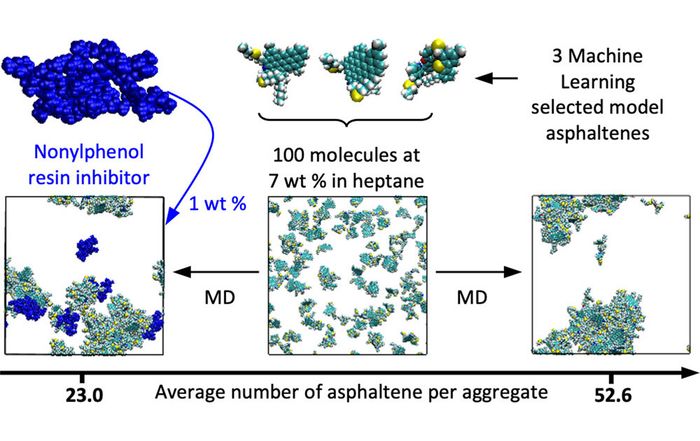Researchers from Nextmol, in collaboration with Clariant Oil Services, have published the paper “Molecular Dynamics Simulations of Asphaltene Aggregation: Machine-Learning Identification of Representative Molecules, Molecular Polydispersity, and Inhibitor Performance” in the journal ACS Omega.

The paper employs Molecular Dynamics simulations to investigate the effect of molecular polydispersity on the aggregation of asphaltene. To make the large combinatorial space of possible asphaltene blends accessible to a systematic study via simulation, an upfront unsupervised machine-learning approach (clustering) was employed to identify a reduced set of model molecules representative of the diversity of asphaltene. For these molecules, single asphaltene model simulations have shown a broad range of aggregation behaviors, driven by their structural features: size of the aromatic core, length of the aliphatic chains, and presence of heteroatoms. Then, the combination of these model molecules in a series of mixtures have highlighted the complex and diverse effects of molecular polydispersity on the aggregation process of asphaltene. Simulations yielded both antagonistic and synergistic effects mediated by the trigger or facilitator action of specific asphaltene model molecules. These findings illustrate the necessity of accounting for molecular polydispersity when studying the asphaltene aggregation process and have permitted establishing a robust protocol for the in silico evaluation of the performance of asphaltene inhibitors, illustrated for the case of a nonylphenol resin.
Reference: Molecular Dynamics Simulations of Asphaltene Aggregation: Machine-Learning Identification of Representative Molecules, Molecular Polydispersity, and Inhibitor Performance Rémi Pétuya, Abhishek Punase, Emanuele Bosoni, Antonio Pedro de Oliveira Filho, Juan Sarria, Nirupam Purkayastha, Jonathan J. Wylde, and Stephan Mohr ACS Omega (2023); DOI: 10.1021/acsomega.2c07120
Read our blog or contact us for more information.